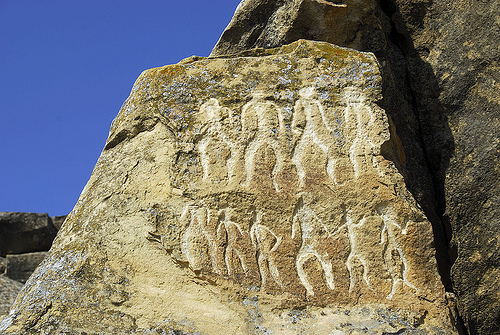

Location: 40 mi (64 km) Southwest of Baku Map
Gobustan Petroglyphs are located 40 mi (64 km) Southwest of Baku,
capital of Azerbaijan. Its name "Gobustan" is derived from the
Turkic language. "Gobu" can be translated as "dried broad riverbed",
"gully" or "ravine", while "stan" means "place". Gobustan
Petroglyphs State Historical- Artistic Reserve is a mountainous
region in Azerbaijan that is famous for numerous rock paintings and
rock art. It covers a total area of 540 hectares. Gobustan
Petroglyphs were left by several generations of people starting with
prehistoric Paleolithic period to the Middle Ages. Even ancient
Roman legionnaires left their mark of the presence in the region
here. Although recently some modern retards decided to add their
share of art by drawing graffiti on some rocks. First archeological
digs in Gobustan began in the 1930's after Ishaq Jafarzadeh
discovered over 3500 Petroglyphs in the area. He further found
sights of human presence including man made rock tools, burials and
caves that were once inhabited by an ancient man.
In 1965 new archeological expedition to the Gobustan region
discovered additional 300 examples of rock art, 20 ancient houses
and at 40 different burials known as dolmens, huge prehistoric
megalithic structures. Ancient people buried their dead under large
artificial hills to mark the grave. In 2007 Gobustan Petroglyphs was
designated as a site of UNESCO World Heritage list. State
Historical- Artistic Reserve covers an extensive area, where people
once lived and left their mark. Additionally a museum was
constructed and dedicated to prehistoric people who once lived here.
Gobustan most visited site is the North- East slope of Mount
Dzhingirdag. Tourists flock here to see a stone Gavaldash. It is
famous for its unique feature, every time it is striken by a stone
it creates various harmonious sounds. The feature is owed due to its
position on an air cusion located below it. It is possible that this
rock was considered sacred in the ancient times so the whole region
of Gobustan might have been viewed as holy by the ancient people. In
addition to petroglyps discovered several ancient sancuaries
including "Sophia Novruz", "Gara atly", "Sophie Hamid" and many
others.
Description
The cave paintings are located in several mountains: Beyukdash (Big
Stone), Kichikdash (Little Stone) and around the semicircular,
largest mountain - Kanizadag - a mud volcano. Amazing drawings are
found mainly in caves, on rock fragments.
The drawings reflect the economic life, life, magical and totemic
representations of ancient people, their religious rites, scenes of
hunting for various wild animals, etc. There are images of men and
women, fishing scenes, various wild animals. You can also find
images of horseback hunters, the lone heroic figure of a reaper with
a sickle, round dances of dancing human figures, boats with rowers
and solar signs. Dancing scenes are depicted on Beyukdash and are
believed to date back to the 3rd-2nd millennia BC. e. By dating, the
first drawings were large, and in later centuries, in the Bronze Age
and subsequent centuries, the size of the drawings decreased. In the
early Middle Ages, in the VIII-IX centuries, and in the late era due
to the fact that the economic role of hunting was reduced, and the
transfer of drawings to ceramic and metal products became more
frequent, and also due to the spread of Islam, which forbade images
of people and animals, drawings on the rocks became simplified to
such an extent that they became sketchy.
In the area of Gobustan, the carving on the rocks by shepherds
remained until the end of the 19th century, and in some cases even
later.
The depicted men, without fail, were in hunting guise and had a bow
and arrow. Their growth was high, the body was slim. There are also
images of battle scenes where in the hands of men such weapons as a
stick or knife are drawn.
The women in the pictures are drawn as representatives of the
matriarchy - full, and women warriors with a thin waist and bows.
Such drawings are found in the cave "Seven Beauties".
Among the drawings, you can also find images of animal species such
as wild goats, deer, gazelles, horses, as well as lions and others.
There are quite a few images of birds, marine animals - fish,
snakes, etc. In addition to wild animals, domesticated, for example,
domesticated dogs are also drawn.
The cave paintings also found reflections of the cattle-breeding and
agricultural sector of the region.
Among the cave paintings of Yazylytepe and Beyukdash, which date
back to the III — II millennia BC you can see scenes of horse
hunting for animals such as antelope, deer, goat, etc. The depicted
weapons were tridents, spears, lassos, and much more. In addition,
there were also drawings of animals pierced by a spear, which
supposedly symbolizes magic rituals.
In the rock paintings of Beyukdash various boats are depicted, in
the bow of some the sun is depicted (in the Bronze Age, the cult of
the sun was widespread in the territory of modern Azerbaijan), as
well as people with bows.
One of the walls has a Latin inscription belonging to the period of reign of a Roman Emperor Domitian (81-96 AD). It indicates that 12th Roman Legion led by Fulminate briefly visited the Caspian shores.